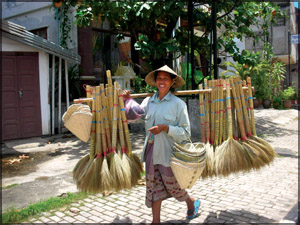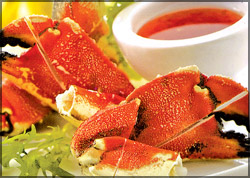Dining
RICE: Economic Boom or Bust? Part VIII
Bojoon.com and CIC has teamed up to review one of the most
controversial debates of Sri Lanka - is rice as an industry worth the
effort.
The discussion so far...
Rice as an industry comes under heavy fire as an unprofitable venture
notes - Senior Consultant Researcher of CIC Agri Businesses Dr. Sumith
Abeysiriwardena. Yet, he points out, instead of been abandoned as such,
rice production over the last six decades has increased by 12 times!
He points out the tremendous demand for rice; ease of handling the
grain and the only crop that can be grown in marshy lands. He continues
that with our technology and our unique hydraulic systems our
productivity is high and asserts that history has proven that rice is
more than our staple, but also our stronghold against our many enemies.
He describes while countries like Australia has made a viable export
and domestic industry, we have decreased our rice consumption for wheat,
making us vulnerable to adverse foreign influences.
He feels that though buffer stock comes with its own set of problems,
it provides a good solution to stabilise our staple, especially with
agriculture being such a vicious cycle.
Our neighbors’ plans and actions certainly seem to be reciprocating
his very thoughts. MD/CEO of Agri Businesses Keerthi Kotagama,
calculates that even with the best estimates, rice shortage is imminent
at least at the tail end of year 2008, and a buffer stock is the only
solution to address this immediate problem.
The discussion continues:
Creating a buffer stock should only be a short term solution states
Kotagama. These are interesting times, he says. Though global rice
production continues unabated with 1.6 billion tonnes of grain
production compared to last year’s 86 million tonnes, the world is
experiencing severe rice shortages.
There are a number of reasons to result in this shortage, explains
Kotagama. One is that the living standards in countries with huge
populations like India and China are rising. As people begin to enjoy
better living standards, their food also changes from a carbohydrate
rich diet to one with protein.
Thus, while the cereal consumption in developing countries remains
static since 1980, the meat consumption has doubled. This has resulted
in manufacturing 250 million tonnes more animal feed than 20 years ago.
For instance, 3 kg of cereals are required to produce 1 kg of pork and
for 1 kg of beef, 8 kg of cereals is needed, he calculates.
Another main reason is the increasing demand for ethanol. In year
2000, US cars used ethanol produced from 15 million tonnes of maize. By
year 2007, this figure has risen to 85 million tonnes. By year 2010, the
European Union targets to replace five per cent of fuel by ethanol.
Global ethanol production has tripled since year 2000 from 18 billion
liters to 60 billion liters by year 2007 and now accounts for three per
cent of the total global transport fuel supply.
With this increasing demand for ethanol, farmers are finding it more
profitable to grow maize than Soya or wheat. US, a previous heavy maize
exporter is now using it for ethanol. Therefore, land that was used for
Soya and wheat are now being used for maize. In 2007, US maize
production of 335 million tonnes is a 25 per cent increase at the
expense of the other crops. Furthermore, US ethanol production is
subsidised to compete against Brazil’s sugar-based ethanol.
When Soya and wheat production decreases, its prices increases and
the demand shifts to rice, points out Kotagama.
Globalisation also has been a cause for these shortages to result,
notes Kotagama. For instance, due to economic reforms, the Indian
Government over the past 15 years had gradually eased their control over
the rice trade, allowing farmers and traders to sell their rice to the
highest bidder. Now, rice that was sold mostly in the domestic market is
exported at a higher price, which increases domestic market prices as
well.
Even though now the Indian Government has imposed a restriction on
exporting non-Basmati rice, the Indian seller is not willing to sell at
a lower price than he would have otherwise got. As they hold on to their
rice, less rice comes into the domestic market at a higher price. These
are the problems of intervention policies, says Kotagama - it has
unintended consequences such as panic, which leads to more hording,
lesser supply and higher prices.
Join Daily News next Friday as bojoon.com unravels with CIC many
mysteries and misinterpretations surrounding rice cultivation in Sri
Lanka. Share your own opinion by simply dropping an email to [email protected].
For more information of who we are, do visit www.bojoon.com.
Lanka to train Lao travel guides
Shirajiv Sirimane
Lao: For the first time Eco Foundation will be training Lao
guides in adventure tourism in Sri Lanka.
 Chairman Eco Foundation Sri Lanka Palitha Gurusinghe said that this
step has been taken consequent to a to a MoU signed with Lao Tourist
Board (LTB) and a ten-member batch for this programme would arrive in
September 1. Chairman Eco Foundation Sri Lanka Palitha Gurusinghe said that this
step has been taken consequent to a to a MoU signed with Lao Tourist
Board (LTB) and a ten-member batch for this programme would arrive in
September 1.
He said that Sri Lankan eco and adventure tourism structure is very
much organised in Sri Lanka than the Lao sector. “This was the reason
for them to sign the MoU and request support from Sri Lanka,” he said.
Gurusinghe said that while sending Sri Lankan groups to Lao they are
also organising tours to Sri Lanka.
“The Lao tourists are keen on eco and adventure tourism and groups
each comprising of 10 will visit Sri Lanka every month,” he said. In
addition exchange of educational programmes too are orgnised between the
two countries.
Gurusinghe who returned from Lao last week said they partronise the
Thai airways for their tour. Airline has two daily frequencies to Lao
capital Vientiane.
Many visitors also take the 10-hour train journey from Bangkok to
Vientiane boarder and then take a Tuk Tuk (three wheeler) to the
Capital.
Most Sri Lankan visitors to Vientiane take the train and fly back on
Thai airways avoiding multiple visa.
Luan Prabhan is one of the most sought out destinations for its
natural beauty while Vang Vieng the former Buddhist monastery turned war
museum is another attraction.
The friendly and uncorrupted people and cheap shopping, food attracts
more tourists to the country. Lao must be explored within the next two
years before it gets corrupted, he said.
Ceylon Continental crab, prawn fiesta
 Ceylon Continental Hotel Colombo will present a delicious crab and
prawn fiesta at the Cafe Emerald from June 22 to 27. Ceylon Continental Hotel Colombo will present a delicious crab and
prawn fiesta at the Cafe Emerald from June 22 to 27.
The fiesta presents a tempting combination of crabs and prawns in a
form of buffet during dinner 7 p.m. - 11 p.m.
One could enjoy a wide selection of crabs and prawns grilled,
curried, baked or even devilled with tempting action stations during the
fiesta. Chili crabs, baked crabs, curried crabs, sweet and sour prawns
and fried prawns with savoury rice cooked to a fine taste to suit the
taste buds will be on offer for all diners.
There will also be a wide selection of fresh green salads with hot
and spicy soups and a delicious dessert buffet with chocolate mousse,
cream caramel. |

